
Topics
Guests
- Mark BenjaminNational correspondent for Salon.com. Along with Michael de Yoanna, he’s written an investigative series examining why returning US combat soldiers are committing suicide and murder in alarming numbers. It’s called “Coming Home” and was published on Salon.com last week.
As many as 143 soldiers took their own lives last year, the highest rate of suicides among US troops ever. We speak with Salon.com correspondent Mark Benjamin, co-author of an in-depth investigation of suicides at an army base in Colorado. [includes rush transcript]
Transcript
JUAN GONZALEZ:
We turn now to the sharp spike in the number of military suicides. The Pentagon reported last month that the rate of suicides among US troops has reached an all-time high, since record-keeping began three decades ago. At least 128, and possibly as many as 143, soldiers reportedly took their own lives last year. This January, the number of military suicides spiked to twenty-four, surpassing the total number of troops killed in Iraq and Afghanistan combined in the same period. Army Secretary Pete Geren announced the number of suicides at a press conference last month.
PETE GEREN: This is a challenge of the highest order for us as an army, and we are doing everything we can to address — every one of us takes every one of these deaths personally. And our commitment is, we’re going to do everything we can. We’re not going to stop until we don’t have any suicides in our army. And our resolve that we feel to attack this problem would be the same if it’s 120 or 110 or a hundred or ninety or eighty. We take every one personally.
JUAN GONZALEZ:
The Army will reportedly begin a suicide prevention program next month to tackle the steadily increasing rates of military suicides over the past four years. But Army Secretary Geren said he had no explanation for why the numbers keep rising.
AMY GOODMAN:
Well, the news website Salon.com just completed an in-depth investigation into a rash of suicides and murders since 2004 at one army base, the Fort Carson base in Colorado. They found most of the deaths were preventable and could have been avoided, but for the neglect and inadequate care returning combat veterans got from the Army.
Salon correspondents Mark Benjamin and Michael de Yoanna wrote, “The soldiers seemed to be suffering classic symptoms of post-traumatic stress disorder: explosions of anger, suicidal and homicidal ideation, flashbacks, nightmares and insomnia. The Army was responding, for the most part, with disciplinary action rather than treatment, evincing little concern for possible underlying problems. The soldiers self-medicated further. Predictable outcomes followed,” they wrote.
Their investigative series on preventable deaths at Fort Carson is called “Coming Home,” published at Salon.com last week. Mark Benjamin, Salon’s national correspondent and co-author of the “Coming Home” series joins us now from Washington.
Mark, welcome to Democracy Now! Congratulations on this very extensive investigation into this unprecedented number of deaths.
MARK BENJAMIN:
Thank you so much, Amy.
AMY GOODMAN:
Talk about how the military is dealing with this, and begin with one case. Begin with Adam Lieberman.
MARK BENJAMIN:
You know, Adam Lieberman is a young soldier who served over a war in Iraq — over a year, excuse me, in Iraq and under extreme combat situations, returned to Fort Carson and was really somewhat typical of what we saw at Fort Carson. What we did is, of course, we took twenty-five deaths, you know, murders, suicides, and whittled it down to ten that we could get access to. We really studied ten of them intensely. One of them was Adam Lieberman.
When he got back from Iraq, he basically was at Fort Carson for two years suffering from symptoms that are pretty typical of post-traumatic stress disorder or combat stress: you know, these anger flashes, suicidal ideation, homicidal ideation, thinking about suicide or thinking about murder, extreme depression. And what happened was the military seemed to resist identifying his symptoms as related to combat. Instead, he was labeled with a personality disorder or just an anxiety disorder — in other words, his own problems, not the war. This is somebody who, like a lot of other folks we looked at, didn’t seem to have any mental problems before he went to war.
Also, when he didn’t get help, you know, Adam did what a lot of the soldiers at Fort Carson did: he turned to alcohol — there’s a lot of drinking out there, a lot of abuse of prescription drugs, really terrifying, actually — and ultimately became so depressed he acted out. You know, when you get drunk, you get in fights, so on and so forth. The Army responded by stripping his rank, punishing him. Ultimately, Adam, in October last year, basically didn’t feel like he had any other way out and made a suicide attempt by taking a tremendous number of prescription drugs. He survived.
An interesting twist, and I think this is unfortunately indicative of some of the attitude at Fort Carson, before Adam died, he painted on the wall his suicide note in big black letters, black paint, where he blamed the Army for his death. He blamed the mistreatment for his death, in this suicide note. “The Army took my life,” he wrote. And his mother flew out there soon after the suicide attempt and found that the Army was responding to the suicide attempt in part by charging Adam with destruction of government property. When his mother found out, she was so angry she half-jokingly offered to paint over the suicide note if they would drop the charges. The Army took her up on it, gave her a can of paint. She painted over her own son’s suicide note, and the Army still charged Adam anyways.
AMY GOODMAN:
I mean, it’s amazing, and I want to let our radio listeners know we’re showing the images, the photographs, for example, of his mother painting over what he wrote: “I faced the enemy and lived. It was the Death Dealers that took my life.”
MARK BENJAMIN:
That’s right. And the Death Dealers were his unit. That was the name for his unit, the Death Dealers. That’s right.
JUAN GONZALEZ:
And Mark, what kind of investigation does the Army conduct, from what you were able to tell about these suicides? Do they try to get to the bottom of what caused them? Do they issue any reports about them at all?
MARK BENJAMIN:
The Army says that they investigate every suicide that occurs in the Army so that they can prevent future suicides. Certainly, the Army investigation unit, which is called the Criminal Investigation Command, does do sort of a post-mortem, if you will, of each suicide. It’s a little bit difficult — when I look at those investigations, they look more to me like sort of just fact-finding. In other words, what did the person do? Did they slash their wrists? Did they take too many prescription drugs? Rather than, you know, looking at whether or not they could prevent future deaths.
What’s interesting is that when we looked at these deaths — and again, there’s a lot of focus on the suicides in the Army because, as you may have mentioned, there were more suicides, more soldiers died of suicide in the month of January 2009 than died in combat in Iraq and Afghanistan. But there’s also these murders going on, as well. When we talked to the Army, basically what they did is they gave us a list of initiatives that they are undertaking to prevent suicide: you know, hiring more counselors, putting together hotlines, putting out memos that are so that people get better diagnosed. But when you go to a place like Fort Carson and you hang out on the base and you meet with the soldiers and you walk the barracks and you go to the hospital and so on and so forth, they just don’t seem to be happening. I mean, these — they look good on paper. You know, when I interviewed the Army, the initiatives that they list sound terrific. They’re just not happening out in the field. And as a result, you know, an unknown number of soldiers are involved in violence, are not getting treatment, they’re self-medicating, and they’re acting out against themselves and against innocent people.
JUAN GONZALEZ:
Tell us about the case of Ryan Alderman, another person that you profiled.
MARK BENJAMIN:
Well, Ryan Alderman, the reason why I’ve spent a lot of time on Ryan’s case is because he was very similar to Adam Lieberman, Adam Lieberman, the soldier who wrote on his wall. The difference was that Alderman did not survive. He passed on just a few days before Adam made his suicide attempt. Ryan was also very typical of what we saw, excuse me, at Fort Carson. He also returned from Iraq, very similar tour to Adam Lieberman. He also suffered what looked like sort of the same symptoms: flashes of anger, suicidal ideation. He also — his medical records — his family turned over his full medical records to us, which was very helpful. And we also got to interview a bunch of his buddies. He had the same problem. It looks, by his medical records, that the Army did not want to admit that his problems seemed to be related to combat. Alderman also turned to alcohol to sort of take care, to try to keep his symptoms under control. He did some typical things that people suffering from post-traumatic stress disorder sometimes do, including self-mutilation, which he was slicing himself. That’s what some people do with PTSD, because they feel so numb; it gives them at least some sensation.
The other thing that happened to Ryan Alderman is, his medical records show him — and this we found a lot at Fort Carson — as opposed to the Army addressing the underlying symptoms, he was given an incredible number of medications, you know, psychotropic medications, depressants — antidepressants, excuse me, and so on and so forth. And in fact, the day he was released from the hospital — this was actually in October also, a few days before Adam Lieberman’s suicide attempt — the records show he couldn’t even talk. He was slurring his words. He was obsessed with getting more Percocet or whatever drugs they had him on at the time. And he was still released from the hospital, despite this extremely high drug load in his body. And he went back to his barracks and took a Xanax, which he was not supposed to have, and overdosed and died. We don’t know whether — the Army says it was a suicide attempt, but the evidence that he actually meant to die is somewhat thin. He may have just been given too many drugs.
AMY GOODMAN:
Finally, Mark Benjamin, why this one base in Colorado did you focus on?
MARK BENJAMIN:
Well, you know, Fort Carson — our reporting suggests that Fort Carson is not an unusual situation, in part because the same people who provide medical care at Fort Carson provide medical are — that’s the Army Medical Command — provide medical care to all Army bases. And we certainly have, since we’ve done the series, have anecdotal reports from all over the country that this is going on everywhere. I picked Fort Carson almost completely by chance. I was there in the summer and in the fall working on a different investigation. It was about an alleged friendly fire incident that soldiers believed had been covered up.
And, you know, I flew out to Fort Carson. The very first soldier I met with, we went to a restaurant. We sat down, and he was obviously intoxicated, very, very nervous, paranoid. And we sat down at a restaurant, and he, of course, sat against the wall so he could scan the whole room. He was obviously under extreme anxiety and suffering from what looked like a lot of stress. And he freaked out because he had forgotten his gun. And we had to go and get in the car and drive to his house so he could be near his gun, because he wouldn’t go anywhere without his gun. And he seemed to be — I asked him whether he was getting any treatment. He didn’t seem to be getting any treatment. And then I met another one of his buddies and another one of his buddies, and a pattern soon began to emerge.
AMY GOODMAN:
Well, I want to thank you very much for being with us. Mark Benjamin has done this incredible series on the unprecedented number of suicides of soldiers returning home.


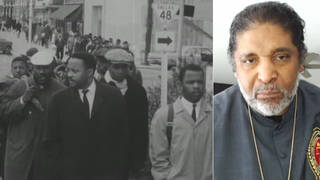

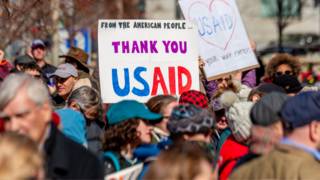
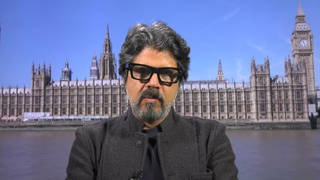




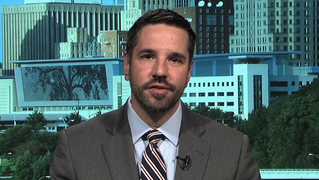
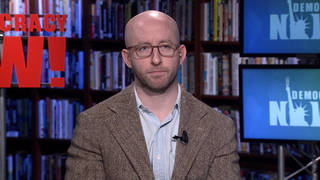
Media Options